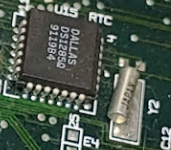That is new information. I was still showing as the last person to have edited the thread. Perhaps you should have created a new post rather than editing the original after I made my earlier post.
The RTC component of the DS1285 is 'ticked' via one of two methods:
* A suitable crystal tied to the X1 and X2 pins (pins 2 and 3), together with exciter circuitry in the DS1285; or
* A 32.768 kHz clock signal applied to the X1 pin (pin 2).
The 'clock signal' method does not appear in the data sheet that I see of the DS1285, but the data sheet indicates that the DS1285 is a "
Drop-in replacement for IBM AT computer clock/calendar", and the IBM AT uses the clock signal method.
Which of the two methods is your DS1285 using ?
If the 'clock signal' method:
As I stated, the IBM AT uses the clock signal method. Per [
here], there is an oscillator circuit providing the subject clock signal. A 'clock not ticking/advancing when AT powered off' symptom is known to happen in the IBM AT when the battery voltage drops below the point where, although still suitable for the AT's RTC chip, is not enough voltage for the oscillator circuit to work.
Volume 1 of the 'PC Engineers Reference Book' makes reference to the situation with, "
The minimum standby voltage for the 146818 is 2.7v, but your settings can remain even down to around 2.2v. Usually, the clock will stop first, as the oscillator needs a higher voltage to operate."
Are you in a position to verify that the oscillator circuit is still oscillating when the computer is powered off ?

